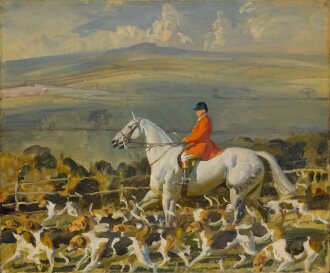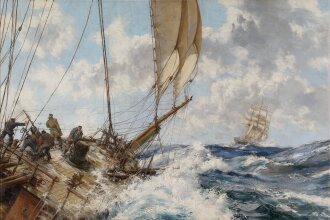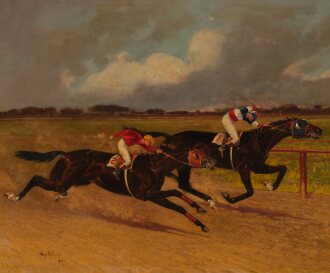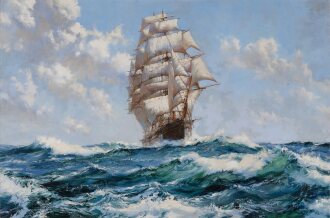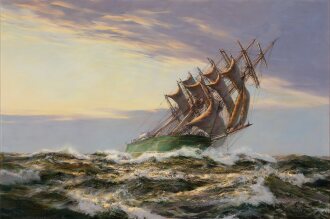S otheby’s is pleased to present the Sporting Life sale, featuring equestrian and marine subjects from the 19th and 20th centuries across painting and sculpture. Sporting and animal subjects showcase unbridled enthusiasm for riding and horse racing in the early part of the 19th century, a passion shared by spectators, amateurs, and professionals alike, who often commissioned such works. The sale presents an iconic group of paintings from The Jockey Club (US), led by John Frederick Herring Sr.’s cinematic The 1828 Doncaster St. Leger Won by The Colonel and other notable works by Edward Troye and Henry Stull, two of the greatest American horse painters of their day. The sale also includes a group of paintings by Montague Dawson, the preeminent marine painter of the 20th century, from a distinguished private collector. From famous clippers and historic ships to racing sailboats and dramatic deck scenes, the selection of paintings assembled here are fresh to the market and represent the very best of Dawson’s daring compositions.
Highlights

Founded in New York City in 1894, The Jockey Club has been dedicated to the improvement of Thoroughbred breeding and racing for over 125 years.
The Club’s primary responsibility, then and now, is the maintenance of The American Stud Book in a manner that ensures integrity of the breed in the United States, Canada and Puerto Rico. The Jockey Club is a founding member of The International Stud Book Committee, which serves to develop and promote the highest standards of stud book operations, international trade, breeding, and racing.
Throughout its history, The Jockey Club has taken a leadership role in critical and wide-ranging areas that benefit the industry. They range from medication and equine welfare to aftercare and marketing of the sport. The Welfare and Safety of the Racehorse summits, the Thoroughbred Safety Committee, the Equine Injury Database, the comprehensive economic study of the sport in 2011 (“Driving Sustainable Growth for Thoroughbred Racing and Breeding”) and the America’s Best Racing initiative are all vibrant examples of that commitment.

Half a century before Eadweard Muybridge's series of cabinet cards capturing a horse in motion, Herring's cinematic composition freezes the rush and excitement of horses flying through the air in physically impossible strides.
This extraordinary early work belongs to an important series of racing pictures that John Frederick Herring Sr. carried out on the occasion of the 1828 St. Leger. Herring captures The Colonel's decisive victory ahead of Belinda, Velocipede, and Besy Bedlam, all of whom are identified by the inscription beneath the group.
In 1815, Herring Sr. was commissioned by a Doncaster publisher to paint the winner of the St. Leger and continued to do so for the next 30 years. He went on to establish himself as one of England’s greatest Sporting artists, counting Queen Victoria among his many patrons, and painted over 60 winners of the day's most important races.
The Colonel was a chestnut colt bred by Mr. Wyvill of Burton Constable, foaled in 1825 by Whisker out of an unnamed mare by Delphini, and bought by the Hon. Edward Petre as a yearling. He was trained by John Scott (1797-1871), arguably the most successful trainer of classic winners, and ridden by John's younger brother, William Scott (1797-1848).

Edward Troye was America's premiere painter of thoroughbred horses and prize livestock during the first half of the 19th century. Born in Switzerland to a French family of artists, Troye may have received early training in England before setting out on his own in the United States, starting his career as a painter and illustrator in Philadelphia in 1831. By 1834, Troye had established a reputation as a skilled horse painter and was traveling throughout the northeast and the south painting portraits of his patrons' most prized animals and the day’s most important races. He exhibited in New York at the premises of the Spirit of the Times, a periodical that published engravings of his work. Over a forty year career, Troye painted virtually every great thoroughbred and racing champion in the country. In 1907, the Jockey Club acquired several paintings by Edward Troye, ushering in an era of renewed interest in the artist and culminating in a landmark exhibition at the Newhouse Gallery in New York 1938.

In the wake of Edward Troye, Henry Stul was considered one of the most sought after painters of American racehorses in the second half of the 19th-century. Stull’s interest in horses began at an early age in the footsteps of his father, a coachman, and on the racetracks in New York where he consoled himself after less than successful attempts to become an actor. Stull’s career as an artist began as an illustrator, with Leslie’s Weekly, and later the horse and sporting magazine Spirit of the Times and eventually Harper’s Weekly, with whom he first published in 1883. Stull’s portraits of horses are notable for their anatomical precision, a skill he homed at a veterinarian college where he was able to study horse anatomy firsthand. Patronized by the breeding, thoroughbred, and racing community, Stull painted over 100 portraits of horses, jockey, and races, several of which were in the collection of The Jockey Club and many more which are today in various public collections including the Kentucky Derby Museum and the National Museum of Racing Hall of Fame.

British painter Montague Dawson (1895-1973) is the most celebrated marine painter of the 20th century. The son of a yachtsman and the grandson of a marine painter, Henry Dawson (1811-1878), his dynamic scenes of ships at sea often center on historic sailing ships, clippers, and warships of the 18th and 19th centuries. His firsthand technical knowledge of shipbuilding and sailing as well as his lived experiences at sea informed his meticulous portrait-like depictions of various vessels in fair and stormy weather, through calm and surging seas, on peaceful expeditions, competitive races, and in combat.

